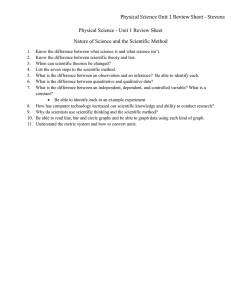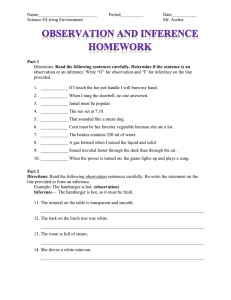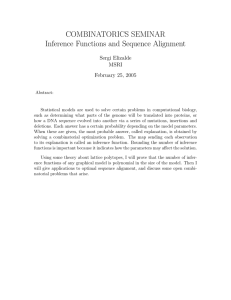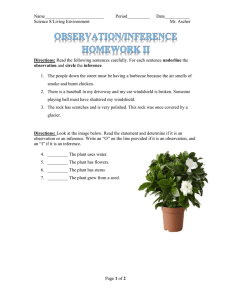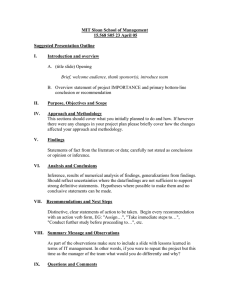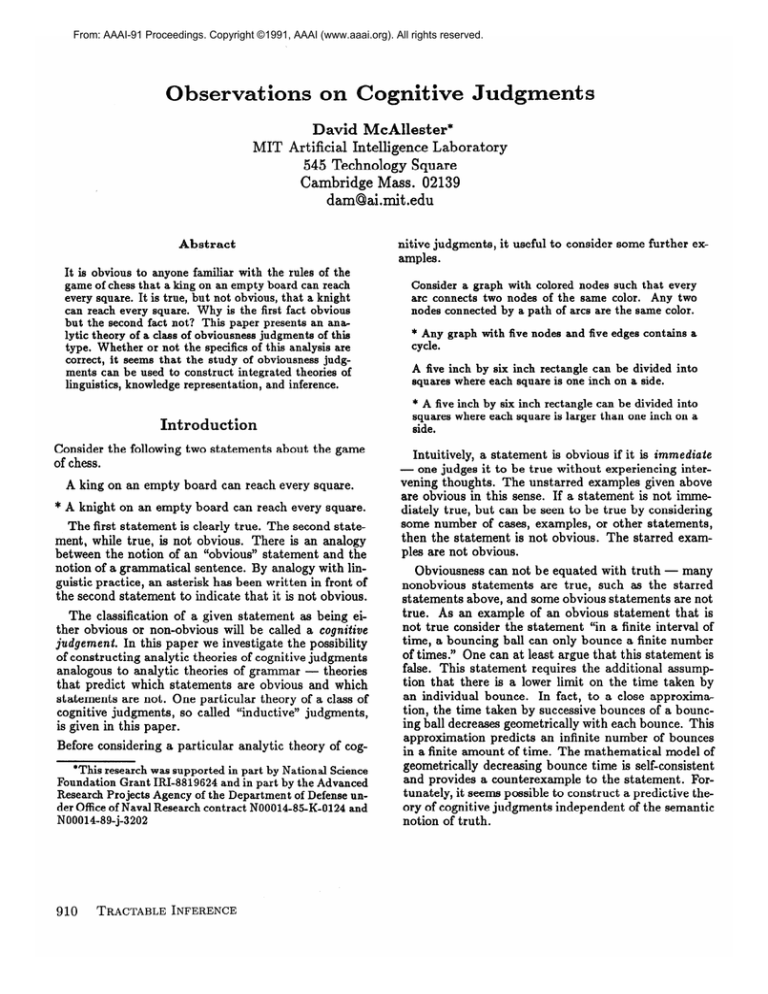
From: AAAI-91 Proceedings. Copyright ©1991, AAAI (www.aaai.org). All rights reserved.
Observations
on Co
David McAllester*
MIT Artificial Intelligence Laboratory
545 Technology Square
Cambridge Mass. 02139
dam@ai.mit .edu
nitive judgments, it useful to consider some further examples .
Abstract
It is obvious to anyone familiar with the rules of the
game of chess that a king on an empty board can reach
every square. It is true, but not obvious, that a knight
can reach every square. Why is the first fact obvious
but the second fact not? This paper presents an analytic theory of a class of obviousness judgments of this
type. Whether or not the specifics of this analysis are
correct, it seems that the study of obviousness judgments can be used to construct integrated theories of
linguistics, knowledge representation, and inference.
Consider a graph with colored nodes such that every
arc connects two nodes of the same color. Any two
nodes connected by a path of arcs are the same color.
* Any graph with five nodes and five edges contains a
cycle.
A five inch by six inch rectangle can be divided into
squares where each square is one inch on a side.
* A five inch by six inch rectangle can be divided into
squares where each square is larger than one inch on a
side.
Introduction
Consider
the following two statements
about the game
of chess.
A king on an empty board can reach every square.
* A knight on an empty board can reach every square.
The first statement is clearly true. The second statement, while true, is not obvious. There is an analogy
between the notion of an “obvious” statement and the
notion of a grammatical sentence. By analogy with linguistic practice, an asterisk has been written in front of
the second statement to indicate that it is not obvious.
The classification of a given statement as being either obvious or non-obvious will be called a cognitive
judgement. In this paper we investigate the possibility
of constructing analytic theories of cognitive judgments
analogous to analytic theories of grammar - theories
that predict which statements are obvious and which
statements are not. One particular theory of a class of
cognitive judgments, so called “inductive” judgments,
is given in this paper.
Before considering a particular analytic theory of cog*This research was supported in part by National Science
Foundation Grant IRI-8819624 and in part by the Advanced
Research Projects Agency of the Department of Defense unand
N00014-89-j-3202
der Office of Naval Research contract N00014-85-K-0124
910
TRACTABLE
Intuitively, a statement is obvious if it is immediate
one judges it to be true without experiencing intervening thoughts.
The unstarred examples given above
-
INFERENCE
are obvious in this sense. If a statement is not immediately true, but can be seen to be true by considering
some number of cases, examples, or other statements,
then the statement is not obvious. The starred examples are not obvious.
Obviousness can not be equated with truth - many
nonobvious statements are true, such as the starred
statements above, and some obvious statements are not
true. As an example of an obvious statement that is
not true consider the statement “in a finite interval of
time, a bouncing ball can only bounce a finite number
of times.” One can at least argue that this statement is
false. This statement requires the additional assumption that there is a lower limit on the time taken by
an individual bounce. In fact, to a close approximation, the time taken by successive bounces of a bouncing ball decreases geometrically with each bounce. This
approximation predicts an infinite number of bounces
in a finite amount of time. The mathematical model of
geometrically decreasing bounce time is self-consistent
and provides a counterexample to the statement. Fortunately, it seems possible to construct a predictive theory of cognitive judgments independent of the semantic
notion of truth.
Linguistic theories of grammaticality are generutive
- an infinite set of grammatical sentences is generated
by a finite grammar. Theories of cognitive judgments
can also be generative. A sequent is an expression of
the form C I- @ where C is a set of formulas (premises)
and Qpis a formula that may or may not be derivable
from C. A cognitive judgement can be formalized as a
sequent plus a specification of whether that sequent is
obvious or nonobvious. We say that a set of inference
rules generates the sequent C t- @ if Qhcan be derived
from C using those rules. In order for a rule set to
be a good predictor of cognitive judgments it should
generate all, and only, the obvious sequents.
The theory of cognitive judgments presented here is
linguistic - it is based on a particular knowledge representation language, a knowledge base, and inference
rules. Of course, one can imagine non-linguistic theories
of obviousness - for example, a theory based on “visual” processing. It remains to be seen whether one can
find image-processing theories of cognitive judgments
with the same predictive power as linguistic theories.
The remainder of this paper can be divided into two
parts. The first discusses local rule sets and their role
in theories of cognitive judgments. The general concept of a local rule set was introduced in (McAllester
1990). The second part of the paper discusses a class of
“inductive” cognitive judgments. An inductive cognitive judgement consists of an obvious sequent where a
formal (syntactic) derivation of the sequent appears to
require reasoning by mathematical induction. Although
no local rule set has been found that incorporates a rule
for mathematical induction, aspects of the theory of local rule sets can be used to construct a formal theory
of inductive cognitive judgments.
ocal Inference
Rules
In linguistic theories of syntax it usually easy to determine whether or not a given string of words can be
generated by a given grammar. For example, given
any particular context-free grammar one can determine
whether or not a given string is generated by that grammar in n3 time where n is the length of the string. Most
well known sets of inference rules are different from
grammars in the sense that it is difficult to determine
if a given sequent is generated by the inference rules.
Inference, unlike parsing, tends to be computationally
intractable.
The apparent computational intractability of inference is a problem in the theory of cognitive judgments
for two reasons. First, one can argue that it is psychologically implausible that the human set of obvious statements is computationally intractable. Second,
and perhaps more significantly, a computationally intractable theory is difficult to test against observed
data. Given a theory of cognitive judgments, and a se-
quent that is judged to be non-obvious, one must show
that the theory does not generate the sequent. For a
complex rule set this can be difficult.
Fortunately, there is a class of sets of inference rules,
the local rule sets, that are analogous to context free
grammars - for a given local rule set one can determine, in polynomial time in the size of a statement,
whether or not that statement is generated by the rule
set. Let R be a set of inference rules. The following
definitions and lemma are from (McAllester 1990).
Definition:
We write C lo R @ if there exists a
proof of @ from the premise set C such that every
proper subexpression of a formula used in the proof
appears as a proper subexpression of a, a proper
subexpression of some formula in C, or as a closed
(variable free) expression in the rule set R.
Lemma: For any fixed rule set R, there exists a
procedure for determining whether or not C I-IR Q[,
which runs in time polynomial in the written length
of C and Q.
We write C /-~a if there is exists any proof of @ from
C using the inference rules in R. The inference relation
b R is a restricted version of +R. For any rule set R,
the relation b R is polynomial time decidable. If the
relation i-~ is intractable, as is the case for any sound
and complete set of rules for first order logic, then the
polynomial time relation b R will be weaker than the
relation I-_R.
Definition:
The rule set R is called local if the
relation t+R is the same as the relation f-n.
An immediate consequence of the above definitions
and lemma is that local rule sets are tractable, i.e., they
generate polynomial time decidable inference relations.
A variety of nontrivial local rule sets is presented in
(McAllester 1990). A n application of local rule sets
to Schubert’s steamroller is described in (Givan et al.
1991).
nductive
Cognitive
Judgments
There is a class of cognitive judgments, that will call inductive judgments, which appear to be most simply analyzed by hypothesizing inference rules for mathematical induction. Consider the following examples, some
of which are given above.
By walking north, a person can never
where they started.
getsouth
of
If a maze containing a rat is placed in a sealed box
then, no matter where the rat runs in the maze, it will
not get outside of the box.
Consider a graph with colored nodes such that every
arc connects two nodes of the same color. Any two
nodes connected by a path of arcs are the same color.
MCALLESTER
911
A scrambled Rubic’s cube is solvable, i.e., there exists
a sequence of moves that will unscramble the cube.
Given a bag of marbles, if marbles are removed one at
a time, eventually the bag will be empty.
A king, on an empty chess board,
square.
can reach every
To construct a set of inference rules that generates
each of the above obvious statements, one must ask
how these statements might be syntactically derived.
The first three judgments can be seen as special cases
of the following general principle.
For any action A and property P, if P is true in the initial state, and, in any state where P is true, P remains
true after performing action A, then P will be true in
any state resulting from any number of applications of
A to the initial state.
This general principle can be used to account for the
walking north example if we assume that “not south of
the initial position” is a property and “walk north” is an
action. In the rat and maze example, “in the box” is a
property preserved by “moving in the maze”. In the colored graph example, “being the initial color” is a property that is preserved by “crossing an arc in the graph”.
The general principle, as stated above, is virtually isomorphic to the statement of the induction principle for
natural numbers. Although the last three judgments do
not appear to be direct applications of the above general principle, they all correspond to statements whose
formal derivation appears to involve mathematical induction. The Rubic’s cube statement can be proved by
induction on the number of moves used to scramble the
cube. The bag-of-marbles statement can be proved by
induction on the number of marbles in the bag. The
king-on-&chess-board statement can be proved by induction on the distance between the king and a target
square.
olynomial Time Inductive Inference
This section gives a rule set that includes an inference
rule for mathematical induction and that can be used to
provide at least a partial analysis of each of the obvious
statements given in the previous section. Although the
rule set is not local, the theoretical framework of local
inference relations can be used to construct a polynomial time inference procedure based on this nonlocal
rule set.
The inference rules are stated in a particular knowledge representation language. Although a denotational
semantics is not required for a formal theory of cognitive judgments, the inference rules are much easier to
“understand” and remember if such a semantics is provided. The knowledge representation language given
here has been designed to be the simplest possible language in which an induction rule can be incorporated
9 12
TRACTABLE
INFERENCE
into a local rule set. The language contains a Kleene
star operation to express an indeterminate number of iterations of an operation. The induction rule is similar to
the induction rule of propositional dynamic logic (Pratt
1976), (Hare1 1984)) (Kozen and Tiuryn 1990). The language described here is also closely related to the knowledge representation language described in (McAllester
et al. 1989).
The classical syntax for first order logic involves two
grammatical categories - formulas and terms. The
knowledge representation language described here also
involves two syntactic categories - formulas and class
expressions. Formulas denote truth values and class
expressions denote sets.
close expression is one of the following.
A class symbol.
An expression of the form (R C) where R is a binary
relation symbol and C is a class expression.
An expression of the form (R” C) where R is a binary
relation symbol and C is a class expression.
@A formula is an expression of the form (every
where C and W are class expressions.
C W)
A semantic modelof the language defined above consists of an assignment of a set to every class symbol
and an assignment of a binary relation (a set of pairs)
to every binary relation symbol. If M is a semantic
model then we write V(e,M) for the semantic value of
the expression e in the model M. If C is a class expression then V(C, M) is a set and, if @ is a formula,
Y(@,M) is a truth value, either T or I?. The semantic
value function V is defined as follows.
If P is a class symbol then Y(P,
interpretation of P in M.
M) is the set that is the
V( (R C), M) is the set of all d such that there exists an
element d’ in V(C, M) such that that the pair <d, d’> is
an element of the relation denoted by R.
C),M) is th e union of V(C, M), V( (R 0,
V(UZ (.2XC,,,M),
‘V(U2 (R (R C>H,M) . . . .
Y((P
Y( (every
WW
C WI,
M)
is T if V(C,
M)
M),
is a subset of
W.
As an example, suppose that a-red-node
is a class
symbol that denotes the set of all the red nodes in some
particular graph. Suppose that a-neighbor-of
denotes
the binary relation. that contains the pair <d, d’> just
in case d and d’ are nodes of the graph and there
is an arc between d and d’. In this case the class
(a-neighbor-of
a-red-node)
denotes the set of all
nodes that are one arc away from a red node. The class
(a-neighbor-of*
a-red-node)
is the set of all nodes
that can be reached by crossing zero or more arcs from
a red node.
(1)
(eeery
c
C)
(1)
(every
C C)
(2)
(every
(every
C W)
W 2)
(2)
(every
(every
C W)
W Z)
(every
C Z)
(every
C W)
(every
(R Cl
(every
C W)
(every C Z)
(every
C W)
(every
(R Cl
(every
C W)
(every
(R” C)
(5)
(every
C (R* C) )
(6)
(every
(R (R” 0)
(7)
(every
(R C) C)
(every
(R* C) C)
(3)
(4)
(3)
(R W))
(4)
(R’
(every
(R” Cl
(5)
(every
C (R* C))
(6)
(every
(every
C W)
(R W)
W))
(R’
Cl 1
(R W))
(preserves
(7)
Figure 1: Some inference rules
(R” W))
C)
R Cl
(every C W)
(preserwes R W)
,(ewery (R C) W)
Figure 1 gives a sound set of inference rules for the
above knowledge representation 1anguage.l For ease
of exposition, let (Rn C) abbreviate (R (R . - (R
C)) ) with n occurrences of R. The expression (R* C)
denotes the union over all n 2 0 of ( Rn C) . Inference
rules 5 and 6, together with rules 2 and 3, ensure that
for any n > 0 we have (every (R” C) (R* C) ) . Inference rule ‘%s an induction rule. Consider the statement
that if every neighbor of a red node is red, then every
node connected by some path of arcs to a red node is
also red. This statements contains a premise equivalent
to the formula
(8)
(every C W)
(every W C)
(preserves
R C)
l
(every
(a-neighbor-of
a-red-node)
a-red-node)
a-red-node).
Let I (for Induction) be the rule set given in figure 1.
Recall that the inference relation I+1 is a restricted version of the inference relation I- 1. The restricted inference relation )-I1 is polynomial time decidable. By
definition, the rule set I is local if and only if these two
‘These rules are apparently not semantically complete.
The formula (every (R” A) B) semantically follows from
(every A B),
(every A Cl,
(every (R B) C), and
(every (R C) B). However, there appears to be no proof
using the above inference rules. A proof could be constructed, however, if we allow intersection class expressions
with appropriate inference rules for intersection. In that
case we could show that R preserves the intersection of B
and 6.
(10)
R W)
(preserves
R (R” C))
(every C W)
(preserves
R W)
(every
CR* Cl W)
Figure 2: An equivalent, more nearly local, rule set
a-red-node).
Inference rule 7 allows us to immediately conclude the
formula
(every (a-neighbor-of*
(9)
(preserves
relations are the same. Unfortunately, the rule set I is
not local. In particular we have
{(every
(every
(R B) B)}
t-1 ( every (R” A) B)
{ (every A B) , (every
(R B) B)}
v 1 (every
A B),
but
(I&* A) B).
The problem is that the proof underlying the first sequent involves the formula (every (R” B) B) (this is
derived from inference rule 7 and the desired result can
then be derived from inference rules 4 and 2). Unfortunately, the formula (every (R* B) B) is not local the class expression (R* B) does not appear in the desired sequent. Since only local formulas are allowed in
proofs underling the inference relation I+1, this proof
can not be used to generate the second sequent listed
above.
A second set of inference rules is given in figure 2.
Let I’ be the rule set given in figure 2. For sequent8
MCALLESTER
913
that do not involve formulas of the form (preserves
R C), the inference relation I- 1’ is equivalent to the
inference relation l-1. However, the restricted relation
t-111is considerably more powerful than the restricted
relation b 1. For example, we have
((every
A B),
(every (R B) B)}
I-II# (every (R” A) B).
As with all locally restricted inference relations, the inference relation I-1I# is polynomial time decidable. We
can take I+18 as a generative theory of obvious inductive
sequents, although any theory with reasonable coverage
of the actual obvious sequents would require a richer
knowledge representation language and more inference
rules.
Unfortunately, the expanded rule set I’ is still not
local - there are sequents generated by t-11that are not
generated by I-II#. However, these examples are difficult
to find and seem to have little, if any, significance in
practice. It is not known whether the rule set I’ can be
further expanded to a truely local rule set.
It seems likely that one can construct large local
rule sets that include rules for mathematical induction.
Such rule sets, or even “nearly local” rule sets such as
that given in figure 2, may have important engineering
applications in areas such as automatic program verification.
Conclusion
Cognitive judgments, i.e., judgments about whether a
given statement is obviously true, can be viewed as a
source of data about the structure of human cognition. Although there is a rich source of fairly unambiguous cognitive judgments, it appears impossible to
gain direct introspective access to the underlying computational mechanisms. On the other hand, it does appear possible to construct generative analytic theories
of these judgments.
Analytic theories of cognitive judgments can be
viewed as being analogous to analytic theories of grammaticality. Local rule sets are ‘analogous to context free
grammars in that the there exists a procedure for determining, in polynomial time in the size of a sequent,
whether or not the rule set generates that sequent. Local rule sets provide a formal framework for the construction of linguistic theories of cognitive judgments.
This paper is, at best, only a first step in the construction of compelling predictive theories of cognitive
judgments. A richer language is clearly needed for expressing generative inference rules. A theory is needed
of the translation of English sentences into formulas of
the internal knowledge representation language. Ideally, the knowledge representation language used to express cognitive inference rules should be the same as
the language used to express the logical form (semantic
representation) of natural language statements. This
914
TRACTABLE
INFERENCE
would allow existing theories of logical form to be used
in constructing theories of cognitive judgments. It remains to be seen whether the basic approach outlined
here can lead to a convincing integrated theory of linguistic logical form and cognitive judgement data.
References
Kasimierz Adjuciewicz. Die syntaktische konnexitat.
Studia Philophica, l:l-27, 1935. Translated as “Sytactic Connection” in Strolls McCall (ed), Polish Logic:
l920-1939 (Oxford University Press, 1967).
Emmon Bach. Categorial grammars as theories of language. In Richard Oehrle and Edmond Bach, editors,
Categorial Grammars
and Natural Language Structures, pages 17-34. D. Reidel, 1988.
Ronald Brachman and James Schmolze. An overview
of the kl-one knowledge representation system. Computational Intelligence, 9(2):171-216, 1985.
Robert Givan, David McAllester, and Sameer Shalaby.
Natural language based inference procedures applied
to Schubert’s steamroller. In AAAI-91, July 1991.
Dynamic logic.
David Harel.
In D.M. Gabbay
and F. Guenthner, editors, Handbook of Philosophical
Logic I’: Extensions of Classical Logic, pages 497-604.
Reidel, 1984.
D. Kozen and J. Tiuryn. Logics of programs. In J. Van
Leeuwen, editor, Handbook of Theoretical Computer
Science,
Volume B: Formal Models and Semantics,
pages 789-840. MIT Press, 1990.
D. McAllester, R. Givan, and T. Fatima. Taxonomic
syntax for first order inference. In Proceedings of
the First International
Conference on Principles of
Knowledge Representation
and Reasoning, pages 289300, 1989. To Appear in JACM.
D. McAllester. Automatic recognition of tractability
in inference relations. Memo 1215, MIT Artificial Intelligence Laboratory, February 1990. To appear in
JACM.
Bernhard Nebel. Computational complexity of terminological reasoning in back. Artificial Intelligence,
34(3):371-384,
1988.
V. Pratt. Semantic al considerations on floyd-hoare
logic. In FQCS76, pages 109-121, 1976.

